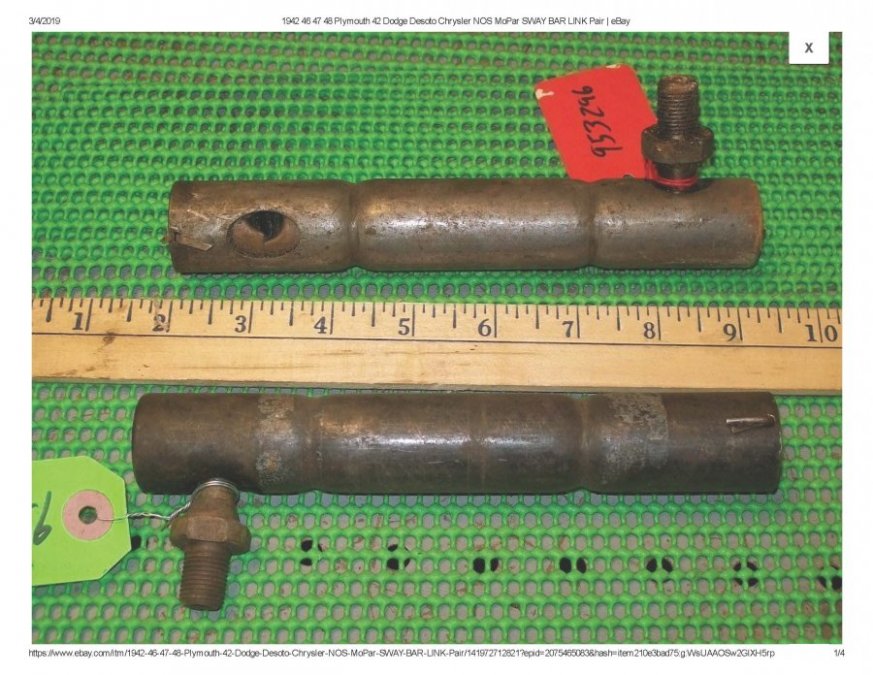
sser2
Members-
Posts
199 -
Joined
-
Last visited
-
Days Won
1
Content Type
Links Directory
Profiles
Articles
Forums
Downloads
Store
Gallery
Blogs
Events
Everything posted by sser2
-
The most difficult problem with AC is that all existing condensers are too wide, as they were designed for modern style cars. Finding space for compressor and re-designing belt drive would be another challenge.
-
The simplest way is to drill out the threads to the diameter of shackle's rubber bushings. It is important to properly center the rear shackles and to tighten silent block's and shackle's nuts only AFTER the car wheels are on the ground and full weight of rear end is applied to springs. Oh, and btw, shackles with rubber bushings are service-free, while old style screw shackles need greasing at regular intervals.
-
Thanks for the great advise. I was leaning the other way, thought that soft springs are better, but was having difficult time finding replacement for my two broken springs. It seems like soft springs were more prone to breaking - there is more offering of firm springs in good condition.
-
According to my parts catalog, 1937 P4 was equipped with either soft or firm leaf springs. Firm springs were the same as used in the P3 economy version. Soft springs have more leaves and leaves are thinner. In particular, soft springs have twin main leaves, while firm springs have single main leaf. What is the difference in ride characteristics between soft and firm springs?
-
Edgy aluminum head with 9:1 compression is #1 approach to increasing Mopar flathead six power for casual driving. Incrementally more power can be gained with transistorized ignition, twin barrel carburetor, and radiator fan delete (use electric fan instead). Don't overlook importance of fine tuning ignition advance and jetting the carburetor. With 20-25% more power, 3.4 ratio rear axle will allow cruising at 60-65 mph at comfortable engine rpm. As to transmission, flathead six and 3 speed transmission is a match made in heaven.
-
Use standard carb adjustment procedure. There are two adjustment screws in a typical carburetor, speed and mixture. Set speed screw so that engine idles smoothly at lowest speed. Then adjust mixture screw to highest idle rpm. Go back to speed screw and re-adjust it again for lowest stable idle speed, then again mixture screw to highest speed. After doing this 3-4 times, both screws will be set to their optimal position, and idle speed should be within specifications.
-
Yeah, '37 Plymouth sedan is 2,800 lb, same as Toyota Corolla. And they said unibody construction saves weight...
-
700-800 lbs in my conservative estimate.
-
1937 Plymouth Rear Springs Settling after rear end swap.
sser2 replied to cturboaddict's topic in P15-D24 Forum
Yes, most likely left spring is sagging or has a broken leaf. If yours are sheathed springs, a broken leaf may not be apparent. There is a seller on eBay (no any affiliation) who has a set of new production springs at a very reasonable price. They will have to be used with rubber bushing rear shackles, and front silent blocks are pre-installed. Rear springs -
What I discovered many times is that the same part may have several different numbers. One needs many parts catalogs from different model lines and years to account for all these numbers. So, if a part doesn't match a number in your book, it does not mean that this is a wrong part. Quite confusing.
-
My book does not have these numbers. 1942-48 All models 871975 Clutch and brake 1949-52 All models 1125541 Brake 1949-52 Ply 1137758 Clutch 1949-51 DeS Chr 1125527 Clutch 1949-50 Dod DeS Chr 1125789 Clutch 1951-52 Dod (fluid dr.) 1125789 Clutch 1951 DeS Chr (fluid dr.) 1329057 Clutch 1952 DeS Chr (fluid dr.) 1327949 Clutch 1952 DeS Chr 1404323 Clutch 1953-54 All models 1329488 Clutch and brake
-
7.2-7.4V is normal charging voltage at 1,200 rpm and above. If it gets considerably above that, battery may be overcharging, so voltage regulator will need servicing and adjusting. 6.4V is normal battery voltage with no load and engine not running. However, this voltage is not an indicator of battery's state of charge: fully charged and almost completely discharged battery have almost same open voltage. Whenever you suspect that the battery is not fully charged (for example after a trip with headlights, heater fan, and radio on, or if car was not used for a couple of weeks), hook up an automatic charger and keep it on until "fully charged" indicator lights up. Automatic charger may be hooked up permanently to maintain the battery in fully charged state.
-
Battery itself may not be a problem. Battery condition critically depends on generator and voltage regulator condition. A little bit off, and the battery is either overcharghing or undercharging, both of them harmful. In addition, generator has low power output and practically no output at low engine speeds. Even if generator and regulator are in perfect shape, battery needs regular maintenance: keeping it fully charged all the time, do frequent top-offs with battery charger, measure electrolyte density, and add water as necessary. Regular flooded batteries are more suitable for 6V system than maintenance-free ones. With 6V, maintenance option is a big plus.
-
I believe your fuel pump is #1 suspect. Many aftermarket electric pumps are junk! Electric pump could overheat and vapor lock. I would dispense with it and revert to original mechanical pump. Ignition components (coil, central wire, capacitor, dist. cap) are less likely. Intermittent trouble in these parts usually results in stumble, misfire, poor acceleration, etc., but not sharp engine cut-off that you describe.
-
eBay - where you can find almost everything, and for bargain price - if you have time and patience. Get Mopar parts catalog for your year to check if parts are right. Once you figure eBay sellers who have reasonable prices, bookmark them and check regularly.
-
Upscale models had better engine tolerances from the factory than bottom of the line, hence lighter weight oil.
- 8 replies
-
- engine oil
- 20
-
(and 1 more)
Tagged with:
-
Earlier sway bar links can be disconnected from the bar only by grinding off the rolled edge at the top. Later ones (shown) have top lid secured by a cotter pin, and those can be disassembled.
-
Congrats on fixing it!
-
Glue them instead with Pliobond High Temerature. It is sold by McMaster-Carr. This is how modern brake shoes are assembled.
-
Anyone doing racing with with flathead six these days?
-
Very educated engineers equipped virtually all NORMAL (I mean not racing) cars not with multiple carbs, but with double barrel sequential open carbs. In drag racing, they don't accelerate like you would do in normal driving. Engine is raced to top speed before car even starts moving. This is poor example to prove your point.
-
This is completely wrong. Multiple carbs indeed increase power, but only at steady high speed. The tradeoff is deteriorated performance at low speed and poor acceleration. This is because with 2 carbs the air flow speed at each venturi is only 1/2 compared to single carb, resulting in poor fuel atomization at lower speeds. Increased air flow increases power only at the expense of higher fuel consumption, so there is no better fuel economy. Fuel economy is worse with multiple carbs because more fuel gets into cylinders in liquid form due to poor atomization. This liquid fuel does not burn and is wasted into exhaust.
-
Exhaust performance 1 Exhaust performance 2 Exhaust performance 3 Just from top of Google search list. Larger exhaust improves performance at high engine speed, especially at speeds approaching top rpm. At low to normal driving speeds, there is no improvement or deterioration. Dynamic performance (acceleration) may suffer. Now I'd like to see evidence for souped exhaust making difference at normal driving.
-
Makes sense only for racing or boasting. On normally driven car, does not make noticeable difference, or even makes it worse.
-
No, installation does not involve heat. Tin (I actually use 30%Sn 70%Pb electric solder) is soft and pliable, so it fills all micro imperfections at the plug/block interface when plug is expanded with a drift.




